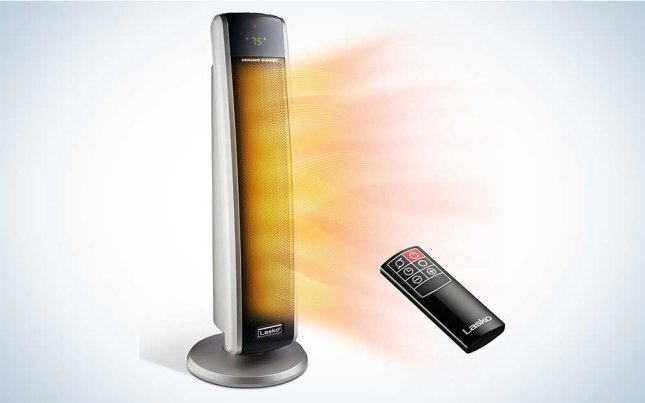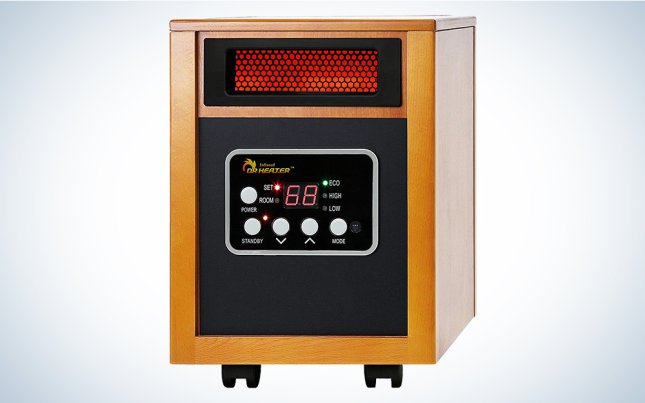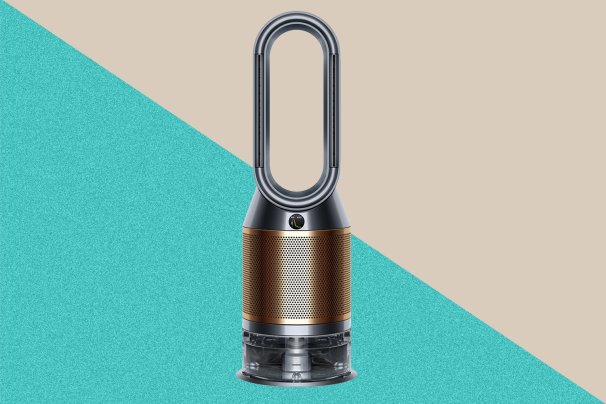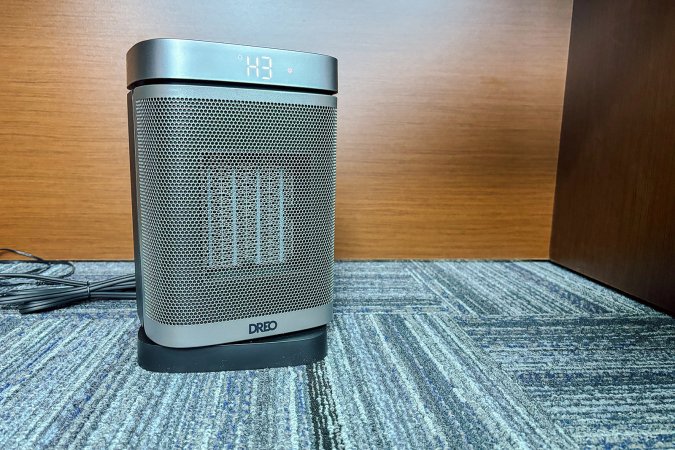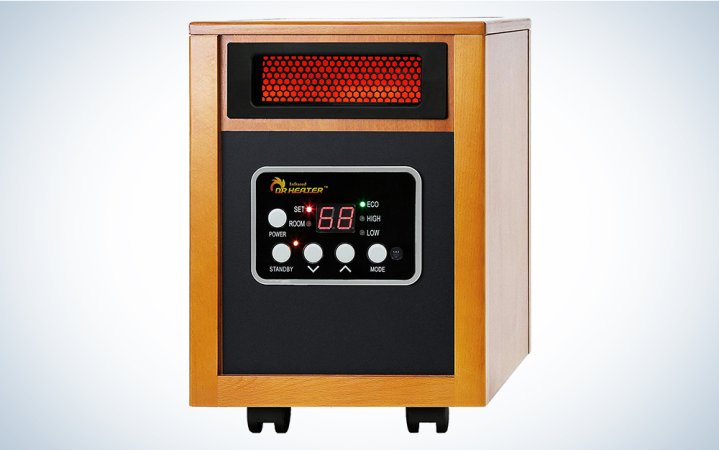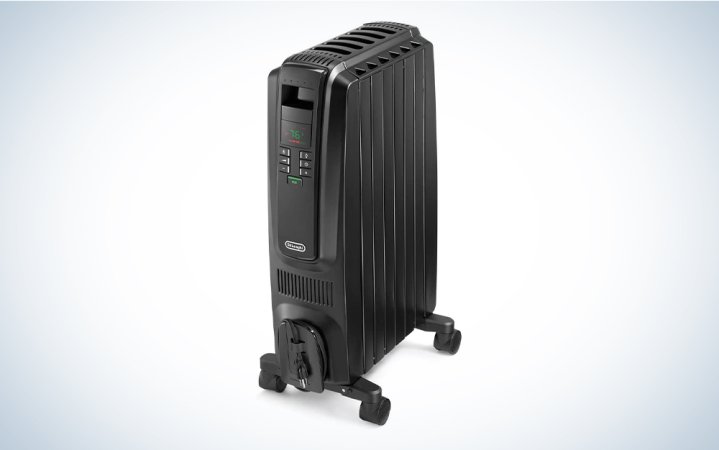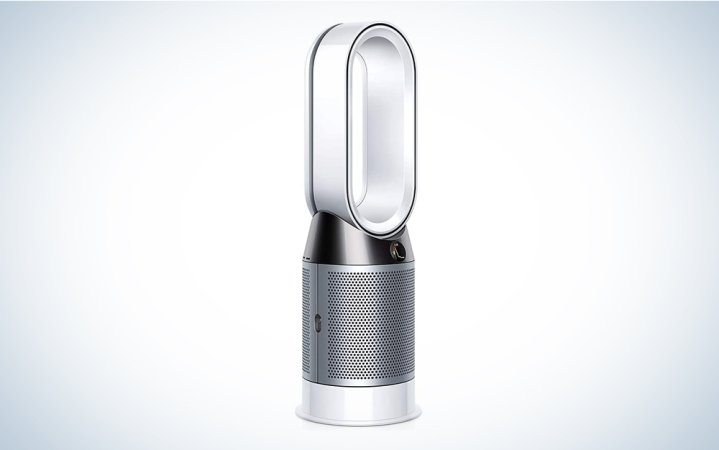We may earn revenue from the products available on this page and participate in affiliate programs. Learn more ›
If you’re tired of stockpiling blankets, extra socks, and heated slippers to keep you warm, it might be time to consider getting a space heater. These powerful appliances are a great way to get cozy without installing a complicated heating system or commandeering the thermostat. If your radiator just isn’t cutting it or someone insists on keeping a window open to freshen the room up, a space heater could be the perfect solution. These hot machines are designed specifically to warm up spaces of all sizes and should be portable, effective, and fast-acting. Our best overall pick, the Lasko 5586 Electric 1500W Ceramic Space Heater Tower, ticks all these boxes. Buying a space heater is a worthwhile home investment, but you want to look at all the information available about each product to determine which will be right for you and your space. To get you started, we’ve created this brief guide to help you learn more about these lean, mean, cold-fighting machines. Get ready to cozy up with your favorite books without reaching for your hat and gloves with the best space heaters.
- Best overall: Lasko 5586 Electric 1500W Ceramic Space Heater Tower
- Best portable: Dreo Atom One
- Best for large rooms: Dr. Infrared Portable Space Heater
- Best energy saving: De’Longhi Oil-Filled Radiator Space Heater
- Best smart: Dyson Pure Hot + Cool HP07
- Best wall heater: Dreo Smart Wall Heater
- Best value: Lasko 1500W Ceramic Tower Space Heater
How we chose the best space heaters
To select the best space heaters that will stave off even the worst winter chills and frigid breezes, we compared over 50 products—looking at reviews, wattage, heat type, bonus features, and brands. From high-tech options like the Dyson Pure Hot + Cool to an energy-efficient oil-filled radiator, these space heaters can suit a variety of needs and spaces. Whether you have a massive room that needs high-wattage heating or are trying to warm up your apartment on a budget, we compared reviews and specs to choose only reliable and quality heaters.
The best space heaters: Reviews & Recommendations
The best space heaters can help you stay warm while you wait for your landlord to turn the radiators on. If you’re always cold, they provide an extra layer of warmth and comfort to your office, living room, bedroom, or garage. We’ve narrowed down some of the cozy space heaters on the market—at least one should melt your winter blues.
Best overall: Lasko 5586 Electric 1500W Ceramic Space Heater Tower
Pros
- Easy to use
- Degree increments
- Remote control
Cons
- Noisy compared to other heaters
Why it made the cut: If you’re looking for a high-quality space heater on a budget, look no further than this tower heater from Lasko.
Specs
- Watts: 1500 watts
- Dimensions: 10.5 x 8.8 x 29.5 inches
- Heating type: Convection
Space heaters can get pricey. Get something that’s budget-friendly—and high-quality—with this Lasko 5586 Electric 1500W Ceramic Space Heater Tower. Like more expensive options, this one is 1500W with low, high, and thermostat-controlled settings. Built-in safety precautions include cool-touch housing and overheat protection. Plus, an auto-off timer gives you peace of mind if you forget to turn this appliance off. It includes an easy-to-read selection pad, carry handle, and six-foot cord for easy transport from room to room. Even better, it comes with a remote control so you can turn up the heat without leaving your spot on the couch.
Best portable: Dreo Atom One
Why it made the cut: The lightweight design with a built-in handle makes it easy to move this space heater from room to room as needed.
Specs
- Watts: 900-1500 watts
- Dimensions: 6.7 x 5.5 x 10.3 inches
- Heating type: Convection
Pros
- Heats very quickly
- Extremely quiet operation
- Automatic shut-off works well when knocked over
- Built-in handle makes it easier to move
Cons
- Not efficient for large rooms
The Dreo Atom One is a compact space heater with a handle that weighs only 3.8 pounds. It’s very easy to move around, which is ideal if you don’t want to buy a space heater for each room in your home but could use a little extra heat everywhere. It also offers some key safety features, such as tip-over protection. I accidentally knocked mine over and discovered this works brilliantly, instantly shutting off to prevent fires.
The Atom One is very fast when it comes to warming up a room. It uses a ceramic heating element to heat up rapidly, making it very efficient for toasting up my small home office. It doesn’t emit any strange odors either, which can happen with some other space heaters I’ve used in the past. The digital thermostat, four modes (including a fan-only setting), and LED panel give you more control over the temperature so you can dial in your comfort level. It also comes with a remote control, meaning I can control the heat without having to get up from my desk chair.
This portable space heater also operates quietly, and I almost forget it’s on. I can barely hear it with my headphones off and can’t hear it at all when I have them on—making it a best bedroom heater pick. Plus, a washable and reusable dust filter helps to reduce dust, pollens, and airborne particles to provide cleaner air in case your air purifier needs some backup. All in all, there’s not much to dislike about this little heater.
Best for large rooms: Dr. Infrared Portable Space Heater
Pros
- 12-hour automatic shut-off
- 50 to 85-degree heat range
- Heats large spaces
Cons
- Heavier and less portable
Why it made the cut: This pick is well-equipped to heat larger spaces like living rooms, large bedrooms, studios, or garages with its high wattage and high temp settings.
Specs
- Wattage: 1,500 watts
- Dimensions: 13 x 12.5 x 17 inches
- Heating type: Radiant
This radiant, infrared heater (its big brother is our best overall pick in this category) heats up big spaces easily and efficiently. With 1,500 watts of power and a heat output temperature of up to 85 degrees, perfect for large rooms, you can stay warm without needing to get up close. It has a 12-hour automatic shut-off timer, remote control, tip-over protection, a 72-inch electric cord, and caster wheels for maximum mobility.
Best energy saving: De’Longhi Oil-Filled Radiator Space Heater
Pros
- Portable design with wheels
- Energy-efficient
- Quiet heating
Cons
- Pricier than some other models
Why it made the cut: Unlike the other space heaters on this list, the De’Longhi pick uses oil to maintain its heat for an energy-efficient and quiet-running design.
Specs
- Wattage: 1,500 watts
- Dimensions: 27.76 x 18.5 x 7.1 inches
- Heating type: Radiant
This energy-efficient space heater will stay hot even after turning it off, extending its heating power without sucking up electricity. Additionally, you can select eco-mode, optimizing power usage with a built-in thermostat for additional energy saving. It has 1,500 watts of power, automatic shutoff to prevent overheating, and thermal slots that funnel hot air while maintaining a low surface temperature so you won’t be at risk of burning yourself.
Best smart: Dyson Pure Hot + Cool HP07
Pros
- HEPA Filter
- Captures allergens
- Sleek and aesthetic design
Cons
- Expensive for a “space heater”
- May be less effective than other models
Why it made the cut: For those who want a multifunction device that can be used year-round, the Dyson Pure Hot + Cool does just that. It filters your air for allergens and dust with a HEPA-certified filter, heats in cooler months, and can act as a fan once the temperatures rise back up.
Specs
- Watts: 1500 watts
- Dimensions: 9.76 x 8.07 x 30.08 inches
- Heating type: Convection
The Dyson Pure Hot + Cool Air Purifier is a dream with all the high-tech, Wi-Fi-connected smart-home features needed to heat and purify an entire room simultaneously (that’s why another one of their models is our top overall pick for home air purifiers). This multifunction feat of engineering treats and projects air, cooling or heating it as needed. It offers 350-degree oscillation, a sealed HEPA filter to trap 99.7 percent of allergens, and voice-control compatibility with Alexa. Equipped with three intelligent sensors, this air purifier, cooling fan, and space heater will also monitor pollution events in real time, alerting you to any problematic airborne particles or gases via the Dyson app—one of the reasons it’s also one of our picks for best garage heaters. The heater/fan has 10 speed settings, Bluetooth connectivity, quiet operation, and multiple additional settings.
Best wall heater: Dreo Smart Wall Heater
Pros
- App and smart assistant connectivity
- Easy to install
- Quiet
Cons
- Might not be the best at heating enclosed outdoor spaces
Why it made the cut: DIY your own home heating system with this easy-to-install wall-mounted heater that can be controlled via a smart assistant or app.
Specs
- Wattage: 1,500 watts
- Dimensions: 4 x 20 x 13 inches
- Heating type: Radiant
If your current heating system isn’t cutting it, consider adding this heater, which looks just like an AC unit but is mounted to your wall instead of a window. 120-degree wide oscillation heating distributes warm air evenly from ceiling to floor to quickly heat the room. You can schedule room heating hours to match when you leave for work or return from walking the dog. Access heater settings via the Dreo app (for iOS and Android) or via your Alexa or Google Home device. Its LED panel automatically adjusts, so you don’t have to worry about the light messing with your sleep. Mounting the wall heater is just as easy as using it. Simply follow the included drilling guide and simple instructions, and you’re done. No more chilly nights worrying about causing a fire hazard.
Best value: Lasko 1500W Ceramic Tower Space Heater
Pros
- 8-hour auto-off timer
- Slim design
- High wattage
Cons
- Only two heat settings
Why it made the cut: This classic-design tower heater can fit in just about any space—and with an oscillating function and impressive wattage, it can heat up a room quickly and efficiently.
Specs
- Wattage: 1,500 watts
- Dimensions: 21.63 x 7.1 x 7.9 inches
- Heating type: Convection
This Lasko ceramic tower heater has a footprint of less than eight square inches but boasts 1,500 watts of heating power, making it ideal for warming up cold rooms in a hurry without taking up too much space. It includes a number of safety features like an 8-hour auto-shutoff timer, overheat protection, and a cool-touch exterior. Its widespread oscillation and adjustable thermostat make it a flexible choice that allows users to custom-tailor their heating experience. The heater’s cable is 72 inches in length, making this model a good choice for rooms with few outlets; plus, the unit includes a multifunction remote control for added convenience.
What to consider when buying the best space heaters
There are six things you should consider to find the best space heater for your needs. Think about what type of personal heater you want, how much space you’re trying to warm, how much power your heater will need, what the safety features are, and finally, what special features might be available. If you can get specific about your requirements, you won’t have any trouble finding a reliable, long-lasting unit you’re happy with.
What type of space heater best fits your needs?
There are three main types of heating, with a few subcategories you should know about.
Convection heating is the most common and efficient type for single-room use. These space heaters work by circulating currents across an element, such as an electric coil or oil, which are often blown out and drawn back in using a fan. Some models don’t include a fan, relying on natural airflow; this method is quieter but takes longer to heat an entire room. Ceramic heaters borrow from this method, using an internal, self-regulating ceramic element and fan to heat a room quickly.
Radiant heating is excellent for warming a targeted area like your bed or desk chair. They heat up almost instantaneously using quartz or other metals and a reflector to direct heat, though some will implement a fan. Infrared heaters are very similar, using infrared quartz bulbs to generate radiating heat. Unlike convection heating, this method will not warm up the air, making it better for targeted warmth. That said, it will heat a room if left on for a long time.
Micathermic heating is an efficient combination of convection and radiant processes. A micathermic heater radiates warmth off of a panel that is then circulated naturally throughout the room. To do this, these space heaters need to be reasonably large, but most models can be mounted on the wall to save space if necessary. Because micathermic heaters don’t use a fan, they are quiet and clean; they don’t circulate dust or pet dander, which makes them great for those who are allergy-prone or have asthma. Portable radiator heaters use micathermic methods to generate heat via oil encased inside.
How big of a room are you trying to heat?
While it’s clear that radiant heaters are best for targeted use and convection or micathermic models might be best for larger areas, there’s more to understand when it comes to room size and heater specs.
When it comes to heating, wattage is king. For space heaters, you want to have 10 watts of power per square foot; this is especially true if your portable heater is the primary source of warmth. If you have super tall ceilings, over 8 feet high, you’ll want to multiply your space’s total square footage by the ceiling height and 1.25. For rooms lacking insulation, add an extra 2 watts to the equation. If you just need a little extra blast of heat here and there, you can relax on the wattage rule, but only slightly.
If you have a lot of ground to cover, it can be hard to find a supplementary heater that will keep you and any guests cozy for hours at a time. Infrared heaters are a bit more flexible because they warm up people and objects; while small models won’t do much, a large infrared heater can cover a larger room because it will target objects as well as people. Below you can find our favorite model.
How much energy will your space heater use?
Using a space heater regularly can suck up a lot of power, so it’s essential to look for energy-efficient models that won’t cause your electric bill to skyrocket. If you want to figure out how much your heater will cost you look up how much you currently pay for electricity per kilowatt-hour (this info is often listed on your monthly bill), determine the amount of time your space heater will be on, and calculate the kilowatts used per hour by dividing the maximum wattage by 1,000. Finally, multiply all three together, and that’s your average cost per day.
Unfortunately, at this time, the United States Environmental Protection Agency hasn’t given any existing space heater an Energy Star rating, but that doesn’t mean you can’t look for models with energy-efficient features. First things first: Don’t buy a space heater that has more wattage than you need. Just because it’s powerful doesn’t mean it’s the best space heater for you. Oil-filled radiator heaters are a great option for energy-efficient heating in a tinier area because they remain hot for a time, even after they are turned off.
Secondly, consider investing in a model that includes a built-in thermostat and multiple output settings. This will conserve energy over time because the heater won’t be overcompensating when the temperature in the room changes. Timed heat settings and automatic shutoff can also aid efficiency, especially if you tend to forget to shut off appliances. Some heaters will come with an auto-eco setting designed to monitor room temperature and suggest a lower output temperature to heat the room, keeping it warm but not hot.
What extra features make the best space heater?
Once you’ve figured out the size, specs, and safety settings you need to narrow down your selection, you can focus on the fun bonuses that make the best space heater. We’ve already mentioned a few helpful features, including a thermostat function, auto-eco mode, and timer settings. Another popular bonus feature is the inclusion of a remote for easy control. This is going to be a lifesaver for those times you get perfectly comfortable, all snuggled up in bed before remembering to turn the heater on.
It gets better: Some space heaters are considered “smart,” which means they can connect via WiFi to your phone, providing a stream of information regarding your space’s air quality, humidity, and more. Some smart models come with a night-time mode to quiet noisy fans, HEPA filters for air purification, and dual-cooling systems that utilize the fan function, bypassing the heat generator. Of course, the more special features you tack on, the higher the price but depending on the frequency of use and overall efficiency of various models, you could end up saving money over time. Higher-quality products experience fewer breakdowns and don’t need to be replaced as often, plus who wouldn’t want to control their space heater using a voice assistant like Alexa? One step closer to building your fully equipped smart house.
What safety features should you keep in mind?
We cannot overstate how important safety features are when it comes to space heaters. These powerful appliances are one of the leading causes of house fires in America, and while we want you to be warm, we certainly don’t want you to be that warm. Luckily, newer models are frequently equipped with safety features that will keep you and your loved ones out of harm’s way.
You need to select a model with a shutoff sensor triggered if the unit starts to overheat or tip over. This small but significant add-on is imperative to keep things safe. You should also consider purchasing a model with a long extension cord, even if you don’t think you’ll need it. Why? Space heaters need to be directly plugged into the wall; a long cord means you can easily resist the temptation to plug it into existing power strips or extension cords for “just a minute.” Consider a model that has a cool-to-the-touch outer layer or handle so you can avoid any accidental burns. Finally, look for certifications from the Underwriters Laboratory and Intertek Group for added reassurance that your model meets safety standards.
While built-in features are important, there are also a few rules you’ll have to follow: as stated, never use power/extension cords to plug in your heater; never put one on a rug or elevated surface; unless specified otherwise, you won’t want to put a space heater near the kitchen or bathroom; and keep them out of reach/away from young kids or pets.
What brand best suits your needs?
There are some great brands out there dedicated to supplying safe space heaters worldwide, and we certainly have a few favorites. Vornado, Dyson, and De’Longhi are staples in the space heater game. Vornado has been around since 1930 and manufactures top-of-the-line space heaters, air purifiers, fans, humidifiers, and more. Likewise, Dyson was founded in 1991 by James Dyson and, today, not only manufactures high-end home staples—such as space heaters, washing machines, robot vacuums, and blowdryers—but also invests in research projects to improve medical equipment—such as ventilators, digital monitors, and electric vehicles.
The Italian company De’Longhi was incorporated in 1950 and is known for excellence in design when it comes to small home appliances such as espresso machines, portable air conditioners, dehumidifiers, space heaters, and more. De’Longhi has been the recipient of multiple awards and certifications for its dedication to high-end engineering, design, and production.
FAQs
Depending on size, wattage, type of heating, and various features, space heaters can start at $30 and go as high as $600.
The space heater that gives off the most heat is the Dr. Infrared Portable Space Heater, which has 1,500 watts to heat larger spaces and can crank up to 85 degrees for maximum power.
The safest type of space heater is one with tip-over protection, a cool-touch case, and an automatic safety shut-off. Our safest pick is the Dreo Atom One—it has those features, and they really work, as our reviewer found out.
An oscillating, adjustable, remote-controlled option can suit a wide variety of spaces, so the best space heater overall is the Lasko 1500W Ceramic Tower Space Heater, which has a classic shape, over 500 rave reviews, and an affordable price tag.
Final thoughts on the best space heaters
- Best overall: Lasko 5586 Electric 1500W Ceramic Space Heater Tower
- Best portable: Dreo Atom One
- Best for large rooms: Dr. Infrared Portable Space Heater
- Best energy saving: De’Longhi Oil-Filled Radiator Space Heater
- Best smart: Dyson Pure Hot + Cool HP07
- Best wall heater: Dreo Smart Wall Heater
- Best value: Lasko 1500W Ceramic Tower Space Heater
Space heaters are a great way to save space, stay warm, and snuggle up safely during cold times. Choose the best space heater for you by examining safety settings, power specs, heater type, and any additional features you find exciting. As long as you know what your space needs, we’re confident you can find the right tiny furnace to keep you from constantly re-wearing your favorite heated socks or heated slippers around the house. Give your puffy coat a break by taking it off indoors as you slowly sink into the warmth of your new space heater.
